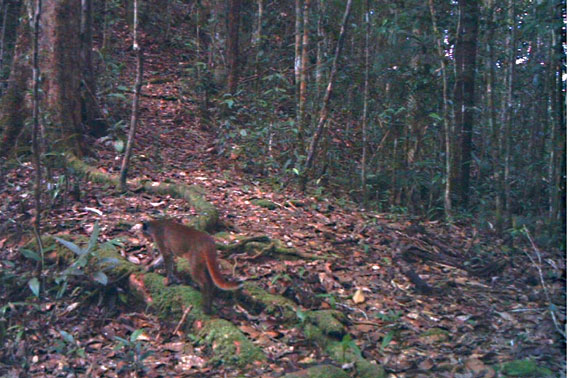
The elusive bay cat, taken by motion-triggered camera-trap in the Kelabit Highlands of Sarawak, Malaysian Borneo. Copyright: J. Brodie & A. Giordano.
Although known to science for 138 years, almost nothing is actually known about the bay cat (Pardofelis badia). This reddish-brown wild feline, endemic to the island of Borneo, has entirely eluded researchers and conservationists. The first photo of the cat wasn’t taken until 1998 and the first video was shot just two years ago, but basic information remains lacking. A new camera trap study, however, in the Kelabit Highlands of the Malaysian state of Sarawak has added to the little knowledge we have by photographing a bay cat at never before seen elevations.
“We’ve never known conclusively whether the bay cat occurred at this high an elevation” said Jedediah Brodie, a Fulbright Research Scholar, who helped conduct the study. “Our record is an important contribution to existing knowledge of this unique and elusive species, and to this amazing ecosystem”.
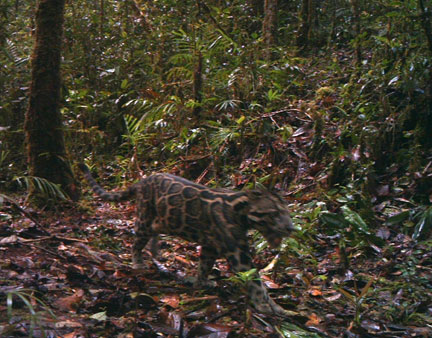 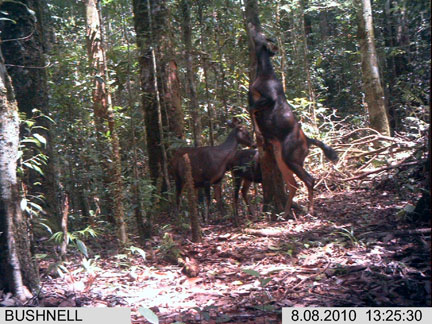 Top: Sunda clouded leopard also caught on camera trap in Pulong Tau National Park. Bottom: sambar also photographed in Pulong Tau National Park. Copyright: J. Brodie & A. Giordano. |
The bay cat is listed by the IUCN Red List as Endangered. Thought to be naturally rare, the bay cat is also imperiled by deforestation due to logging and palm oil plantations on the island of Borneo, though the cat has been photographed in previously logged forests, but not plantations. The bay cat is not alone in its plight: four of Borneo’s five wild cats are classified by the IUCN as threatened with extinction due to continued deforestation, but the bay cat is only one of those found no-where else in the world.
“Although Borneo’s lowland forests are without question a primary regional conservation concern, we are only beginning to learn the wealth of biodiversity that these highland regions harbor,” Anthony Giordano, the founder and director of S.P.E.C.I.E.S., a new carnivore conservation organization. “The fact that we now know the bay cat occurs here could change the way we approach future efforts to locate it.”
The conservationists warn that although the cat was photographed in Pulong Tau National Park, the park is only protected on paper.
“This is a ‘paper park’ for sure, currently with no budget, no infrastructure, and no staff, including no park rangers” explains Brodie. “Given that we have recorded such a rich mammal fauna, we urgently need to see that it receives the additional scientific attention and protection it deserves.”
The camera trapping expedition also recorded several other endangered species including the Sunda clouded leopard (Neofelis diardi), marbled cat (Pardofelis marmorata), banded civet (Hemigalus derbyanus), sun bear (Helarctos
malayanus), sambar (Rusa unicolor), bearded pig (Sus barbatus), pig-tailed
macaque (Macaca nemestrina), Hose’s langur
(Presbytis hosei), tufted ground
squirrel
(Rheithrosciurus
macrotis), and Bulwer’s
pheasant
(Lophura bulweri), all of the above of which are listed as Vulnerable by the IUCN Red List.
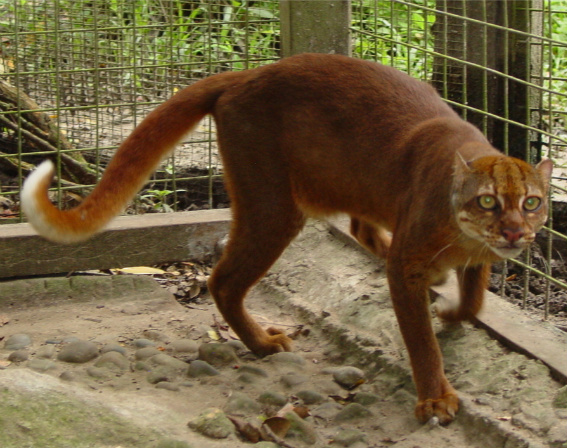
Captive bay cat. Photo by: Jim Sanderson.
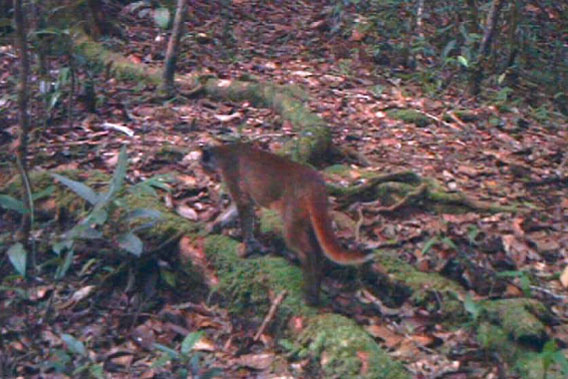
Close-up of bay cat. Copyright: J. Brodie & A. Giordano.
Related articles
Photos: five wild cat species documented in Sumatran forest imperiled by logging
(11/16/2011) A single forest corridor in Sumatra has yielded camera trap photos of five wild cats species, including the Critically Endangered Sumatran tiger (Panthera tigris sumatrae). Photos were also taken of the Sunda clouded leopard (Neofelis diardi), the marbled cat (Pardofelis marmorata), the Asian golden cat (Pardofelis temminckii), and the leopard cat (Prionailurus bengalensis). The five species were all filmed by a WWF camera trap survey in a single forest corridor linking the forest of Bukit Tigapuluh and the Rimbang Baling Wildlife Sanctuary in Riau Province. Unfortunately this forest remains unprotected.
First ever survey shows Sumatran tiger hanging on as forests continue to vanish
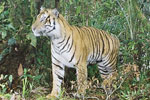
(11/10/2011) The first-ever Sumatran-wide survey of the island’s top predator, the Sumatran tiger (Panthera tigris sumatrae), proves that the great cat is holding on even as forests continue to vanish. The study, carried out by eight NGOs and the Indonesian government, shows that the tiger is still present in 70 percent of the forests surveyed, providing hope for the long-term survival of the subspecies if remaining forests are protected.
Illuminating Africa’s most obscure cat
.150.jpg)
(10/18/2011) Africa is known as the continent of big cats: cheetahs, leopards, and of course, the king of them all, lions. Even servals and caracals are relatively well-known by the public. Still, few people realize that Africa is home to a number of smaller wild cat species, such as the black-footed cat and the African wild cat. But the least known feline on the continent is actually a cryptic predator that inhabits the rainforest of the Congo and West Africa. “The African golden cat has dominated my thoughts and energy for over a year and a half now. When carrying out a study like this one, you find yourself trying to think like your study animal,” Laila Bahaa-el-din, University of Kwazulu Natal graduate student, told mongabay.com in a recent interview.
